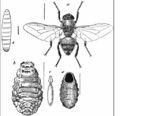Hypoderma spp.
Jump to navigation
Jump to search
Scientific Classification
| Kingdom | Animalia |
| Phylum | Arthropoda |
| Class | Insecta |
| Order | Diptera |
| Family | Oestridae |
| Genus | Hypoderma |
- Also known as warble flies
- Important cattle parasites
- Also parasitise horses, small ruminants and sometimes humans
- The two main species in cattle are
- H. bovis
- H. lineatum
- H. diana parasitises deer
- Infestation is largely confined to the Northern Hemisphere
Recognition
- Large 13-15mm long
- Similar to bumble bees in appearance
- Yellow abdomen
- Band of black hairs
- 1 pair of wings
Life cycle
- Adult flies emerge on warm, sunny days between June and August
- White eggs are laid around the belly and legs of the animal
- Eggs are attached to hairs by cement and a small terminal clasp
- H. lineatum lays a whole row of eggs as it approaches the animal stealthily
- H. bovis only deposits a single egg before the animal runs away (gadding) as it makes a loud buzzing noise
- The adult lives for 3 weeks
- Females can lay several hundred eggs in their life
- A few days after eggs are laid, larvae emerge and crawl down the hairs into the hair follicles
- Larvae penetrate the skin through wounds made by biting flies
- Larvae migrate through the subcutaneous tissue towards the diaphragm
- Enzymatic secretions and mouth hooks aid larval migration
- After 3 months larvae reach winter resting sites where they remain from November to February/March whilst moulting to the L2 stage. These sites are different between the 2 species
- Epidural fat in the spinal canal for H. bovis
- Wall of the oesophagus for H. lineatum
- Larvae then migrate back to the subcutis along the midline of the back where they bore a breathing hole through the skin and moult to the L3 stage
- Larvae are palpable as distinct swellings called warbles
- L3 larvae emerge after 4-10 weeks where they fall to the ground and pupate under loose vegetation
- Adult flies emerge from the pupa after 1 month where they copulate, lay eggs and die within 2 weeks
- H. lineatum are on the wing 6-8 weeks before H. bovis
- There is only 1 generation of warble flies per year
Pathogenesis
- Causes myositis
- Production losses
- Condemnation and down-grading of hides
- Reduced milk yield and reduced weight gain
- Injury from stock panic
- Trimmed meat losses from H. lineatum
- 'Butcher's Jelly' around warbles which is green due to mass eosinophil attraction
- Paraplegia resulting from
- Toxin release
- Pressure on the spinal cord (H. bovis)
- Bloat from pressure on the oesophageal wall (H. lineatum)
Control
- Total eradication should be aimed for
- Old methods include popping out warbles
- But this could lead to anaphylactic shock
- Ectoparasiticides
- Systemic organophosphorus insecticides in pour-on formula
- Avermectins and milbemycins in pour-on and injectible formulations
- Timing is crucial for treatment
- Larvae residing in winter resting sites, if killed, can lead to bloat and paraplegia
- It is safe to treat in the autumn before larvae reach their winter resting sites and in the spring when the warbles have migrated to the midline of the back
- Ivermectin can be given at any time without risking host infection as larval antigen is released much slower
Legislation in the UK
- 'Warble Fly Order 1978' requires all clinically affected animals to be treated
- Notifiable disease
- 'Warble Fly Infected Area Order 1983'
- For more information on the warble fly orders, see here
in cattle
- May occasionally burrow into muscle
